Have you ever heard of the forgetting curve? (If not, maybe you just forgot you ever learned about it!) It’s a natural phenomenon that’s especially unfortunate for language learners because it proves how difficult it can be to retain the things we learn. Fortunately, a German psychologist came up with a way to combat the forgetting curve, and today we have the Spaced Repetition System (SRS). It’s a key feature in all of our apps because it helps users actually remember the vocabulary they learn. It’s been scientifically proven, and we are big fans here at MosaLingua. Keep reading to find out what the SRS is and how it can make you a better language learner.
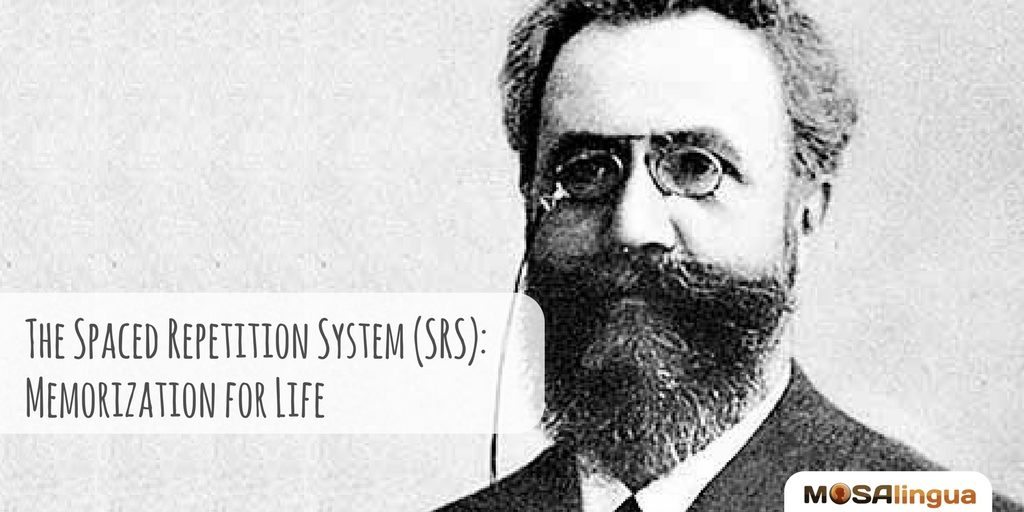
What Is Spaced Repetition, Anyway?
Spaced Repetition is a learning and memorization technique. As you probably guessed, it’s based on one simple idea: spacing out your study sessions to better commit information to your long-term memory. First, you learn a new vocabulary word. The more you study it, the easier it is to remember. And eventually, by way of some strategically timed review sessions, it makes its way into your long-term memory.
History of Spaced Repetition Systems

A man named Hermann Ebbinghaus created a long list of nonsense syllables (e.g. daus, dor, gim, ke4k) and memorized them over the course of one year, keeping a record of his progress and using various learning methods.
To check his results, he repeated the same experiment 3 years later. From this experiment, he formed the earliest notions of learning curves, forgetting curves, and spaced repetition.
Spaced Repetition System: The Secret to the Most Efficient Memorization Possible
The spaced repetition method of memorization is based on Ebbinghaus’s forgetting curve and the fact that there is an ideal moment to review information you have learned.
If you review information too early, you’ll waste your time. If you review information too late, you will forget it and will have to re-learn it. In fact, the best time to review information is just before you’re about to forget it.
Is it magic? Nope, just an algorithm
Evidently, it is hard to predict when that time will be. And the time differs for each person and each piece of memorized information. However, computers and smartphones have made it possible to predict the ideal time for review.
It took nearly a century of research by scientists like Piotr Wozniak to model the forgetting curve mathematically and create an effective algorithm to present information for study at just the right time.
But that’s only half the battle! Of course, not all words are equally easy to learn. For example, if you’re an English speaker who is trying to learn French, the word “un exercice” will probably be pretty easy for you to remember since it means “exercise” in English. But something like “traitement anti-pelliculaire” (anti-dandruff shampoo)? Yeah, it’s a little bit trickier!
Other challenges
Along those same lines, not everyone’s memory is equal. Memorization is based on lots of factors, and it comes easier to some people than to others. (Of course, you can work on improving your memory, by making changes to your lifestyle and eating habits, for instance. But for now, let’s focus on how technology can help!)
The algorithm Wozniak developed from the forgetting curve adapts to users’ needs and takes difficulty into account to prompt a study sesh at exactly the right time.
As you can see in the diagram, you are likely to forget information quickly if you only learn it once. The blue line is pretty steep, meaning that one day after you learn something new, there’s only about a 60% chance you’ll remember it.
For your first review session, the spaced repetition system algorithm will give you information to review shortly after you learned it (between 7 and 24 hours, depending on difficulty).
See how the second curve, in red, is already a lot less steep than the first? That means that it’ll take longer for you to forget the info that you just studied.
The algorithm will present you with information to review less and less often (unless you have trouble remembering it) until you’ve committed the info to your long-term memory.
Putting Wozniak’s algorithms to use
For decades, Wozniak studied and improved upon these principles. Then, he created a company to market the program. It’s called SuperMemo, and it has been very successful, especially for people who want to learn reputedly difficult information, like Japanese characters or medical terms.
Then in the spirit of science, and to the delight of many, Wozniak published his algorithms. A number of programs were subsequently developed. One of the most well-known is Anki, which includes vocab lists you can download. You might have heard of another program that was developed based on his algorithms… none other than MosaLingua!
Learn more about how it works and why it’s so useful
MosaLingua co-founder Luca recorded a video all about how and why the spaced repetition system in our apps is so effective. Watch it on our YouTube channel or right here, then give it a try! The video is in English, but there are subtitles in 5 other languages. If you’d like to turn them on, just click the gear icon in the corner.
If you liked this video, subscribe to our YouTube channel! We post new videos every week.
MosaLingua and SRS: A Love Story
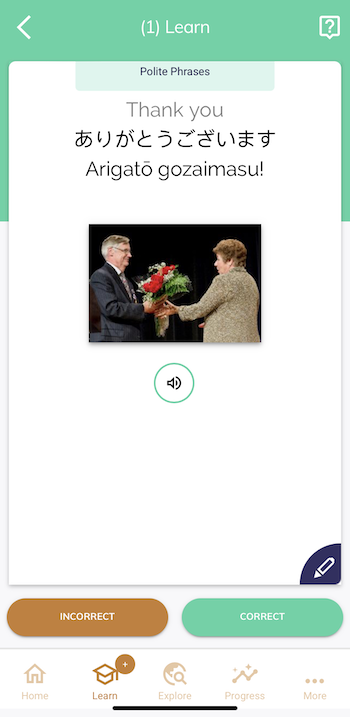
But Anki is complicated. It suggests ready-made lists for users to download, but the lists aren’t necessarily adapted to specific needs. There are no audio recordings, and words are not organized by frequency of use. (Not to mention, the iPhone version of Anki will set you back about $25.)
How MosaLingua came about
The part that took me the longest was compiling a list of vocabulary and inputting it into the Anki software. Then I realized that my list needed some work. I could remove some words and add others. I improved the list during my trip, and upon my return, I worked extensively with a Spanish professor to improve it even further. By the end, my list had over 3000 words and phrases, organized into 15 categories and sub-categories, and ordered according to usefulness.
I went on to develop an iPhone application for learning Spanish and worked hard with other professors and travelers to adapt this list for other languages (English, Italian, French, and German, to name a few). And that’s basically how MosaLingua was born! If you want to learn more about our humble beginnings, read about us here.
MosaLingua’s Spaced Repetition System
All of the MosaLingua apps use Wozniak’s algorithm, so they can calculate exactly when you should review a word or phrase you’ve learned.
But that’s just one part of the complex calculation that goes on inside your app. It learns about you and makes adjustments based on how hard it was for you to memorize previous words. It factors in your motivations for learning. And using a self-evaluation technique, it also takes into account how easily you remember each flashcard.
Start learning a new language today
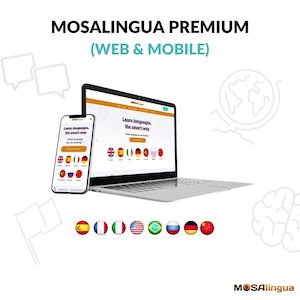
Good news: we can help!
More good news: you can get started for free! Start your free trial now and for the next 15 days, take advantage of the most effective language learning method on the market!
Vocabulary flashcards, videos with subtitles, audiobooks, articles adapted to your level – with MosaLingua Premium (Web & Mobile), you’ll have access to all this and more. Get started right now. It’s free—and risk-free—to try!
More on self-evaluation, because it’s a key part of the system we use. For each word you review with MosaLingua, you’re asked to rate how easily you remembered it. If it was perfect, if it was okay, or if it was difficult for you to recall. And if you can’t remember it, you can flip the flashcard over and try again later in the session. Depending on your rating, the algorithm makes a few adjustments to determine when it should give the card to you next. If it was really hard for you to remember a certain term (think back to the example of “traitement anti-pelliculaire“) your app will prompt you to review it again sooner than other words that you deem easy (like “exercice“).
What you end up with is an app that is personalized, because it adapts to your unique needs, and optimized, because it helps you focus on the flashcards you find most difficult.
What’s Great About SRS
As opposed to cramming (trying to “memorize” lots of things in a short amount of time), this is an ideal revision method. Like we said before, it takes fewer review sessions (and less time) to memorize new info, and it’s much more sustainable. Since you’ll focus on the most difficult information, you won’t waste time learning and relearning easy words or words you already know.
It’s not about studying for hours and hours on end. It’s about studying at the right time. Which is, as you should know by now, right before you forget what you’ve learned. 10 to 15 minutes a day is all it takes to sustainably memorize new foreign-language words and phrases.
Of course, for the technique to work, you have to study your flashcards when the app tells you to! Consistency and regularity are both super important if you want to be a successful language learner, even with the best spaced repetition system on the market. Cédric explains why:
And what’s great about MosaLingua
You might be wondering how MosaLingua is different from other apps and learning techniques that use a spaced repetition system, like Anki for example. There are four main things that set it apart.
-
Focus on what’s most important
Like I said before, we worked closely with language teachers to put together the vocab lists featured in your MosaLingua app.
We didn’t just pull words out of thin air, either. The lists we came up with are based on the vocab that is most commonly used in each language. A.k.a., the most useful stuff you need to know! Frequency lists and the Pareto principle played a big role in the process. We introduce the 20% of a language’s vocabulary that will be useful for 80% of situations you’re likely to encounter. Click here to learn more about the Pareto principle.
-
Customized learning
As I said, for each word you practice, your app will ask you to rate how well you remembered it. If it was hard for you to remember, your MosaLingua app will prompt you to review it again soon. If it’s easy, you probably won’t see it in your practice stack again for several days or more.
This system makes for a super personalized approach to learning, and also helps you focus on exactly what you need to learn a language.
And before you begin, you can even tell the app why you want to learn. Whether it’s for travel, for love, or for business, you’ll learn the most important words and phrases for the specific purpose you have in mind.
-
Appeal to (almost) all of your senses
Every time you learn a new word with your MosaLingua app, you’ll learn how it is spelled, see a picture that describes it, and hear it spoken by a native speaker. This multifaceted approach is part of what makes our apps so effective. It activates multiple aspects of your memory, notably your visual and auditory memories. We explain more about how your different memories work together in this article.
-
Variety is the spice of life
Aside from your basic flashcards, MosaLingua has lots of extra features related to language learning. Bonus content like jokes and fun facts, learning tips, mini lessons, plus videos from our teachers and team members will keep you busy and keep you from getting bored! If you want to successfully learn a language, it’s important to enjoy the process.
MosaLingua also borrows concepts from cognitive science and psychology to keep you motivated to learn. To find out more about that, check out our article about the MOSALearning® method.
And if you missed the first part of this article, all about memory and forgetting curves, click below to head straight there!
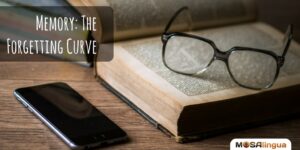
Happy learning!

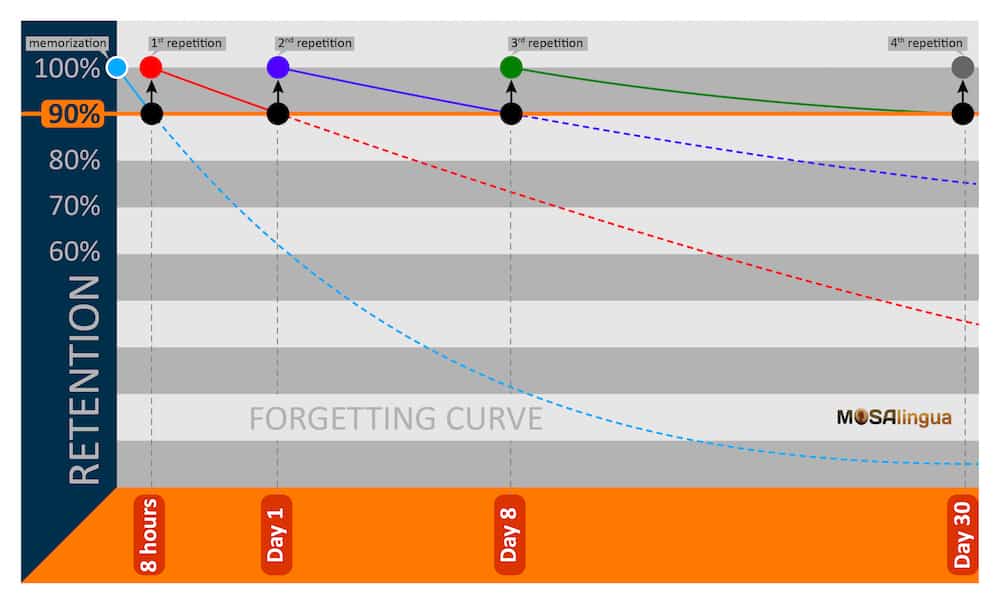
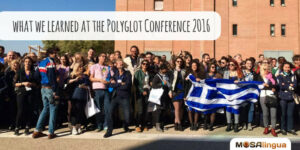



Is it Latin American Spanish?
Hi there !
With the Spanish app, we tried pleasing as many people as possible.
For the accent, we chose to have a voice from Latin America with a neutral accent. One that is understood both in Spain and in Latin America.
As for the words used, some words obviously differ in Latin America and Spain, so when they do differ, you will see both.
For example, you might see « El coche (ES) / El carro (LA) ». LA means this is a word/expression used in Latin America, while ES means it’s used in Spain.
I hope this helps!
Samuel W
Hello,
I bought Mosalingua from the appstore, and it is really great, during the last 3 months I learnt about 900 flash cards, but I want to ask you; is there a way to copy the flash cards of Mosalingua to Anki on my PC?
Sometimes I want to learn from my PC and I want to put Mosalingua flash cards along with my other flash cards in Anki. If there a way to do that please tell me how.
Thank you
Hello,
No, sorry, it’s not possible, but we are working on a web version of MosaLingua that will be released this year.
Hope this help,
Best regards,
Sam
Any update on the web version? This would be very useful!
Hi Patrick,
Thanks for your sharing your opinion!
Yes, we are working on it. We are going to create a poll on the website so you will be able to add your suggestion.
Best,
Patricia
Feel free to ask questions here about MosaLingua.
I want to learn Spanish, but I want to learn the Spanish spoken in Mexico, rather than the ‘peninsular’ Spanish of the EU. Will your program work for me? Also, please don’t forget the folks who prefer a more open source approach than Apple, and a huge consumer demographic; those who use Android. Do you have an app for this portion of the consumer market?
radio
Hello and thanks for your comment. We offer vocabulary from both Latin America and Spain, however we don’t necessarily have specific Mexican terminology. We try to teach the most commonly used terms/phrases from the region. Also, the MosaLingua apps are available for Android as well as Apple. Please do not hesitate to contact us at support_en@mosalingua.com with any additional questions or concerns.
Best,
Diana